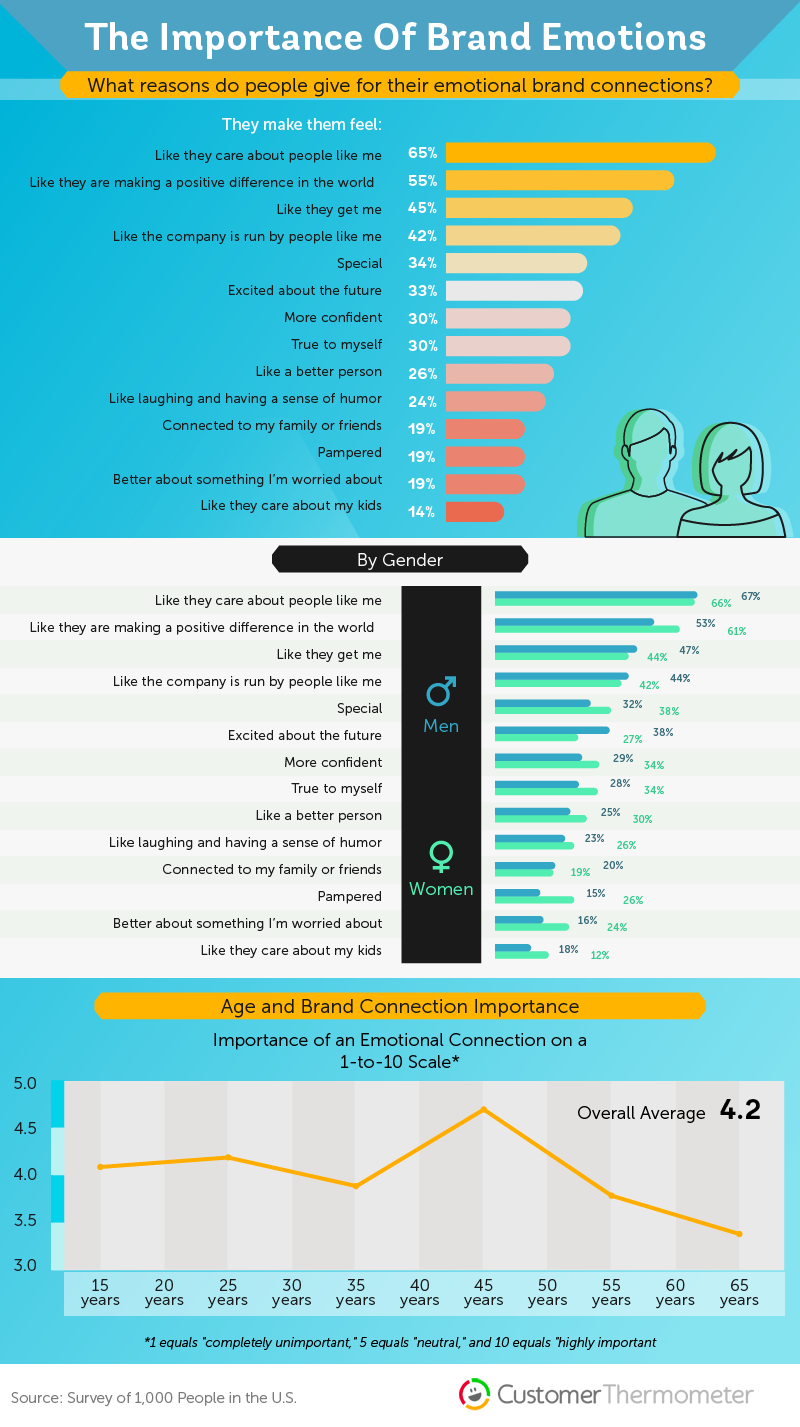We harp on you regularly about how important it is to produce informative content, and 66% of consumers expect brands to understand their needs. Emotion, however, is what drives your messages home, demonstrates understanding, and gets people to buy.
It turns out that the mad men of Madison Avenue had one thing right. Although they didn’t often nail the informative part, they knew instinctively that the way to customers’ purse strings was through their heartstrings.
Relating to your target audience while providing helpful information is how to build trust, encourage loyalty, and boost conversions. It’s a balancing act, but let’s look at how you can create emotional content that also drives sales.
Balancing Emotional Content and Helpful Information
Science has spoken. According to brain researcher Dan Hill, the emotional part of your brain processes information in one-fifth the time your conscious, rational self does. Furthermore, the brain signals that travel from the emotional aspect of our brain to the rational side outnumber those that run in the opposite direction ten to one.
Talk about a shortcut to your customers’ wallets. Now, that’s some clout.
However, it’s equally important for emotional content to have a firm basis in fact. You may be tempted to craft a content strategy that leads with emotion, but it’s even more critical to undergird your customers’ urge to buy with facts.
The Role of Empathy
Putting yourself in your customers’ shoes allows you to create content that addresses both their emotional uncertainties and rational concerns. Furthermore, consumers desire connections with the brands they invest in.
Creating emotional content demonstrates empathy for your audience. Mirriam-Webster defines empathy as “The action of understanding, being aware of, being sensitive to, and vicariously experiencing the feelings, thoughts, and experiences of another.”
Empathy shows consumers you care about them, get them, and are like them. In other words, it helps to create connections while addressing emotional uncertainties and rational concerns.

Source: Customer Thermometer
The Trust Factor
Trust is critical to the customer experience, but global consumers trust only about 47% of brands. In North America, the percentage of trusted companies drops to 39.
Successful content marketing depends more on what happens after the sale than the pre-sale hype. Sales and customer retention will suffer if your product doesn’t live up to the hype.
What’s more, you might discover that your customers turn into your worst nightmare. Negative online reviews, plus the power of word-of-mouth, can ruin a brand’s reputation in a heartbeat.
The Impact of Neglecting Emotional Content

Source: SalesForce
Maria Ross, writing in Entrepreneur, put it best: “If your sales team doesn’t intimately understand your customers’ lives, how can you expect them to explain how your products or services fit their lives?”
Bingo.
The same goes for content marketing. If you don’t show customers how your product will help them long after the shine rubs off their new toy, they won’t recommend it to their friends and colleagues.
Despite all your best marketing efforts, most of your customers’ buying decisions will come down to word-of-mouth. A 2021 Nielson survey found that 88% of respondents trusted product recommendations from people they know over any type of advertising.
Creating Content With Empathy at Its Core
Now you know why you should create emotional content. “But how do I infuse empathy into my content strategy?” you ask.
Expand your content calendar with content that helps current and potential customers solve the kinds of challenges that keep them up at night, advises expert content marketer Michael Brenner. We agree.
It’s simple. With information that helps customers research these problems, teaches them how to maximize their investment in your products, and answers their questions, you can have the kind of empathy that shows that you understand.
Divvy’s content calendar is also simple. It makes it easy to plan and schedule emotional content suitable for your target audiences.
Use Customer Personas as a Springboard for Empathetic Content Ideas

One of the essential elements of content planning is discovering who your customers are. Using audience personas — fictional personalities that embody your customers’ characteristics — can give you insights into their deepest emotional and physical needs.
Use your content analytics program to dig into the data to identify these customers’ demographics, interests, and problems. Then, create content that touches on those areas, only bringing your products onto the scene as a solution to problems or as educational tools to help these customers learn more about subjects that interest them.
Show your audience that you not only feel their pain but also understand what sparks their joy. You’ll hit the empathy sweet spot when you create emotional content imbued with facts.
Use Keyword and Topic Research To Learn What Your Customers Are Curious About
Investigate the types of questions your target customers ask online. These questions can give you deep insights into their emotional and physical needs.
Using a comprehensive content marketing platform like Divvy provides you with a one-stop shop for researching these questions, brainstorming content that answers them, and collaborating on the type of content that best answers your audience’s questions. Teams outside your marketing department are often the best sources of information for answers to customers’ questions, and we give you control over setting permissions to allow participation from collaborators outside your department and company.
Content collaboration lets you go beyond keyword research to ask your sales teams what questions and objections customers have. Then, you can pull from your engineers’ and other subject matter experts’ insights to create content that answers your target audience’s questions with information they can trust.
Use Emotional Words and Images To Get Customers’ Attention
Customer research tackles the needs and wants of your customers, providing the basis for a connection to your emotional content. You need to get their attention before they get into the meat of it. Emotional words can do just that.
Emotional Words
Forget about Grammarly’s suggestions. Artificial intelligence hasn’t quite gotten the knack of human emotion. I don’t know how many times I’ve proofread a piece of content only to find that the grammar police have targeted me for a traffic stop. Like when I use:
- “Tough” or “hard” instead of “difficult”
- “Better” instead of “superior”
- “There’s more” instead of “additionally”
Generative AI tools, such as Writer or Jasper, are scratching the surface of emotive language. However, only you really know your customers and can appeal to their emotional needs using language they can relate to.
Use Plain Talk
Often, as long as you’re not making grammatical errors, plain talk grabs your audience by the heartstrings and is better for emotional content than industry jargon or formal language. Turns out, my choices are often higher on the emotional scale than the AI’s more precise yet less-feeling choices.
Use Active Voice
Grammarly absolutely nails one type of word usage — the active voice. Choosing words that show action involves your reader in your story. Use “When researchers examined the data” instead of “When the data were examined by the researchers” for best results.
The next time the grammar police stop you for using passive voice, take the time to change your wording.
Use Power Words
Power words that create emotional connections between potential customers and your products can get their attention in a single phrase or word.
For example, including phrases in emotional content that convey the fear of missing out (FOMO), like “Don’t pass up your chance,” can drive customers to take the next step in their customer journey. Other words (such as “now”) can create an internal itch in customers’ brains.
Using the word “you” in your content (See, I just used it!) makes your content personal. Reading it makes you feel connected to the writer and their story.
Emotional Imagery

As one of our regular guest contributors, Victoria Greene, observed, pictures and moving images (videos, gifs, etc.) tell a thousand stories without a word. Not only does content with a visual element pull on your audience’s heartstrings, but it also makes people remember it up to six times as well.
Give Your Products Personality
Create emotional content by giving your products a personality. Victoria tells a story that drives that point home. She says, “I can pick up a pencil, tell you its name is Steve, then break your heart a little by snapping it in two because people can connect with anything.”
Make your audience feel empathy, and you’ll win their hearts.
Don’t believe her? Just watch the ads on TV some evening. You’ll see rabbits and squirrels representing your socked-away dollars on Voya ads, a cheeky gecko that saves you money on car insurance, and yeah, a talking toilet roll that puts personality into even a product as serious — and yucky — as a stool test for colon cancer.
Use Brand-Forward Color Palettes
The color palette you choose is integral to emotional content that incorporates imagery. As Victoria pointed out, you can’t see a Halo Top webpage without getting hungry. Their minimalist, perky palette of pastels makes you think, “I want ice cream.” Even if it’s a diet brand.
Coca-Cola is another master of the color palette. Whether it’s their flagship beverage or new flavors, the colors they use in their labels make you thirsty the moment you see them.
Evoke Wonder With Animation or Scenic Vistas
There’s a child in each of us. The right imagery can take us right back to hot summer days at the beach or rainy Saturdays watching cartoons. It can also instill in us the sense of awe we had observing a butterfly or seeing endless stars in the night sky.
Using breathtaking images or charming animations evokes a sense of childlike wonder in your audience. When you infuse your content with those kinds of emotions, you create a connection that will make your customers identify with your brand and be more open to doing business with your company.
Using Divvy To Help You Create Emotional Content
Now, it’s time to put the power of emotion to work in your content marketing strategy. Divvy’s platform makes it easier to create emotional content. We place all the necessary tools in one central location, taking your mind off the frustrations of working from countless tools and platforms and letting you focus on what’s important. Let us help you simplify your marketing life. Request a demo today to see how we do it.
